The TyBurn Tree
the lives & times of JoHnny Haddo ~
Thursday 11 June 2020
Tuesday 1 August 2017
England's Shame: Managing Risk and Uncertainty
Oz Hardwick
Jerry sat awkwardly in the brown leather armchair in The Princess of Prussia, his stiff limbs refusing to sink into its soft curves. The air smelled of fresh cut onions. He cast his eye along the neat row of stools, hard against the bar, remembering the arses that had occupied them last time he’d been here, some time in the previous century. Some, he reflected dispassionately, he had fucked, while others – figuratively, at least, though occasionally literally – had fucked him. Had times, on balance, been any better then? They had certainly been a bit clearer, for all the millennial entropy.
He fumbled in the pocket of his crushed velvet jacket, and pulled out a dented silver case, monogrammed with his initials and a cheeky crucifix and Playboy bunny motif. It had once stopped a bullet in a war, though he couldn’t recall which war. Perhaps this one. He shook loose one of his few remaining gold-tipped cigarettes and hung it loosely from his cracked lower lip. Any port in a storm. At the third strike, his Lucifer guttered to a yellow light, the whiff of sulphur at least providing a momentary sense of security. He hadn’t noticed when smoking, like so much else, had become illegal but, if he’d thought at all, he’d have considered there was little chance of customers, even, much less a raid.
A shadow passing the fake Victorian glass made him tense briefly. A mitre? But no-one came in.
The walls told the tired story of Empire. A Toby jug in the shape of Shakespeare. Adverts for soap, with fat children and a cat. Why is there always a cat? Posters from the Varieties, with acts he faintly remembered, and to whom he thought he may be related: strippers, dog trainers, acrobats and blues guitarists. A plastic Union Jack, with the Saltire painted out, drooping from an ice bucket.
At last the door opened. The man who entered was smooth-skinned, with a fixed expression of surprised concern that somehow resolved itself into an avuncular grin. His tie was loose, but he was still clearly uncomfortably hot, sweat glistening across his forehead.
“Mr Smiles?” asked Jerry flatly, neither standing nor offering his hand.
“You can call me Dave,” he said, lowering himself into the seat opposite and presenting his moist palm.
The brief hiss beneath the table was barely noticeable, nor was the sharp expiration as the needle pierces the dummy’s groin. The face looked no more surprised, but began to collapse on itself, growing first baggy, then sinking into a broad smirk, then twisting through an ugly sequence of ever more grotesque metamorphoses as the body crumpled over the chair. Leaning forward, Jerry regarded the sparkling, dead eyes of what now resembled nothing more or less than the Spitting Image puppet of Margaret Thatcher.
Jerry drew on his cigarette, stood up, and turned to leave.
“Where do you think you’re going?” nagged a voice behind him.
He turned to look, and saw the puppet standing, ungainly, legs splayed too wide, head nodded like a movie zombie.
“On second thoughts,” she spat, “call me Theresa. And I can assure you, Mr Cornelius, that a change is coming. A very big change.”
Friday 18 November 2016
INFINITE WORLDS: A BRIEF HISTORY OF THE COMIC BOOK MULTIVERSE
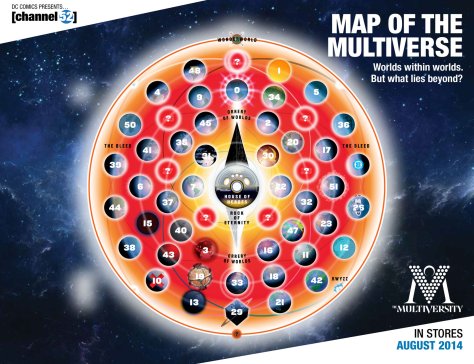
Both DC Comics’ Multiversity series and Marvel Comics’ Edge of Spider-Verse event showcase characters from multiple parallel universes (that is, a “multiverse”). These two series are not the first time that the multiverse concept has been used by DC and Marvel. Over the years, the publishers have each established a multiverse of parallel universes in their respective comics, and the concept has become a popular element of superhero comics.
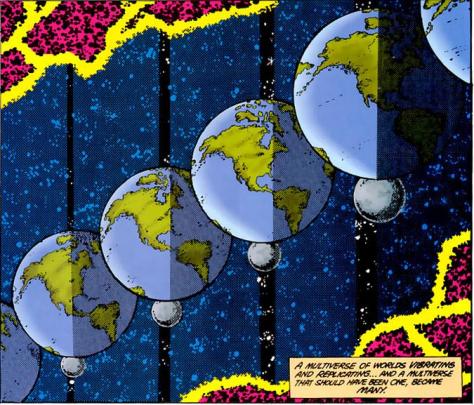
The concept of “parallel worlds” – defined by The Science Fiction Encyclopedia as “another universe situated ‘alongside’ our own, displaced from it along a spatial fourth dimension” – has a long history that predates science fiction. The parallel world concept can be found in ancient philosophy (for example, Platonism), religion, folklore, and myth (Heaven, Hell, and Asgard can be described as parallel worlds), and literature (Lewis Carroll’s Through the Looking Glass).

Stories featuring parallel worlds were popular in pulp science fiction magazines and the concept was also used in comic books. For example, in Captain Marvel Adventures#80 (1948), the comic’s titular superhero travels to a parallel world where a painter’s surrealist creations are real. More significantly, in Wonder Woman #59 (1953) Wonder Woman is transported to a parallel Earth when her lasso is struck by lightning. There, Wonder Woman encounters her twin, a superhero named Tara Terruna. For the first time, a superhero met another version of herself on a parallel world.

In 1956, DC Comics editor Julius Schwartz oversaw the revival of the comics character The Flash. First appearing in Flash Comics #1 (January 1940), the original Flash was Jay Garrick, who gains the power of super-speed after inhaling hard water vapors. The character’s adventures continued through the 1940s, the period labeled by comics historians as the “Golden Age of Comics”, and ended in 1951, when superhero comics lost their commercial appeal and were replaced by other genres like Westerns and horror comics.
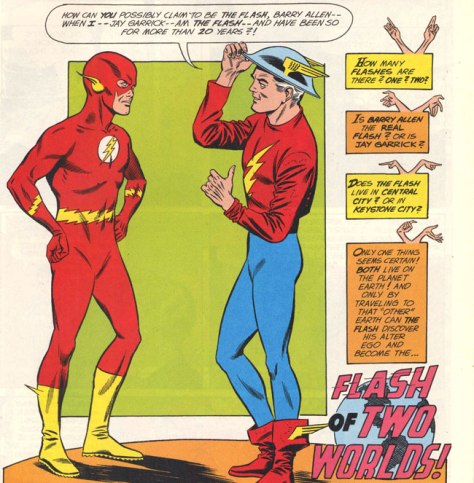
Schwartz kept the superhero’s name and superpowers, but changed The Flash’s design and alter-ego. The Flash was now Barry Allen, a police scientist who gains super-speed when he is soaked in lightning-charged chemicals. The new Flash debuted in Showcase #4 (October 1956). Significantly, the comic acknowledges the original character’s existence; indeed, Barry Allen is inspired to assume his superhero identity because he reads the fictional comic book adventures of the Golden Age Flash.

The new Flash was commercially successful, reviving reader interest in superhero characters and comics; The Flash was the first superhero of the period comics historians label the “Silver Age of Comics”. At DC Comics, The Flash was soon joined by Silver Age superheroes The Atom, Hawkman, and Green Lantern; all of these heroes were based on past Golden Age superhero characters.
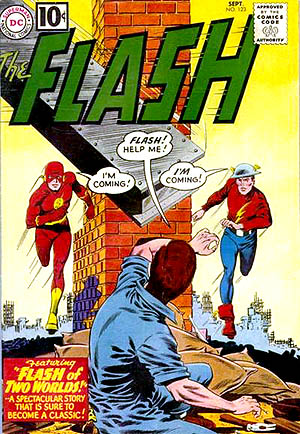
Comics fans were eager to see the return of the Golden Age Flash, and DC Comics obliged. The two Flash characters first met in The Flash #123 (September 1961) in the story “Flash of Two Worlds”, using the parallel world concept; the Silver Age Flash vibrates his molecules at a different frequency at super-speed and is accidentally transported to a parallel world, where the Golden Age Flash fought crime in the 1940s and is now retired.
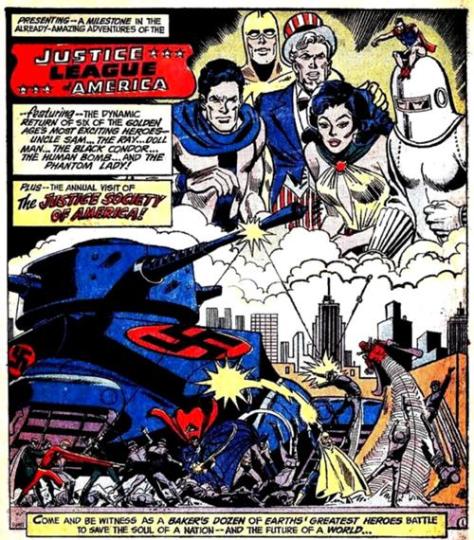
This parallel world (identified as “Earth-Two” in future stories) was the home of Golden Age characters like The Flash, The Spectre, and The Sandman, while Barry Allen’s world (“Earth-One”) was the home of the modern DC Comics superheroes. Soon, DC Comics added other parallel worlds, like Earth-Three (the home of supervillain versions of the Justice League of America), Earth-S (the home of Captain Marvel and other Fawcett Comics characters purchased by DC), and Earth-X (where the Quality Comics characters purchased by DC – Uncle Sam, Black Condor, etc. – fought the Nazis, who won World War II on that world). DC Comics soon had a robust fictional multiverse.
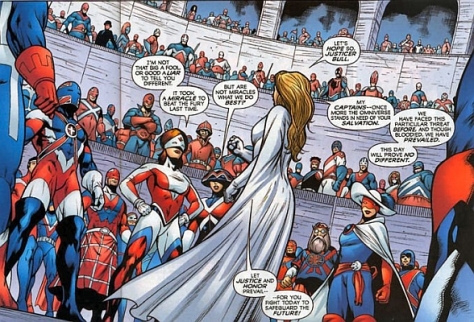
While DC Comics’ multiverse grew to include many parallel worlds, DC’s primary competitor, Marvel Comics, was slow to utilize the concept. Although Marvel featured stories with parallel worlds (such as the Negative Zone in Fantastic Four, Asgard in The Mighty Thor, or the dimension of the Squadron Supreme – superheroes based on DC Comics characters – in The Avengers ) it was not until 1983, when writer Alan Moore created the Captain Britain Corps in the pages of the Captain Britain strip, that a multiverse of parallel worlds – protected by the Captain Britain Corps – is identified. The strip’s titular hero is the Captain Britain of Marvel’s primary Earth, identified as Earth-616.
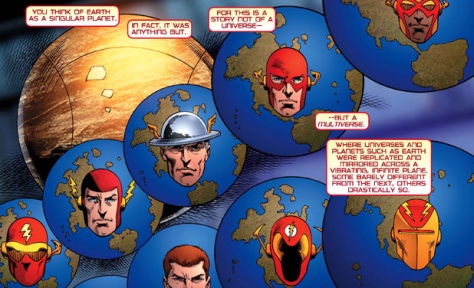
In 1985, DC Comics destroyed its multiverse in the crossover event Crisis on Infinite Earths, which revised DC’s narrative history so that there was now only one Earth; the Golden Age characters appeared in the 1940s and retired in the 1950s, but inspired the modern superheroes that came after them. However, DC Comics revived the multiverse concept in its weekly 52 comics series (2006) and the subsequent Flashpoint crossover event (2011), so that there are now 52 parallel Earths. These parallel Earths will be explored in the upcoming Multiversity series.
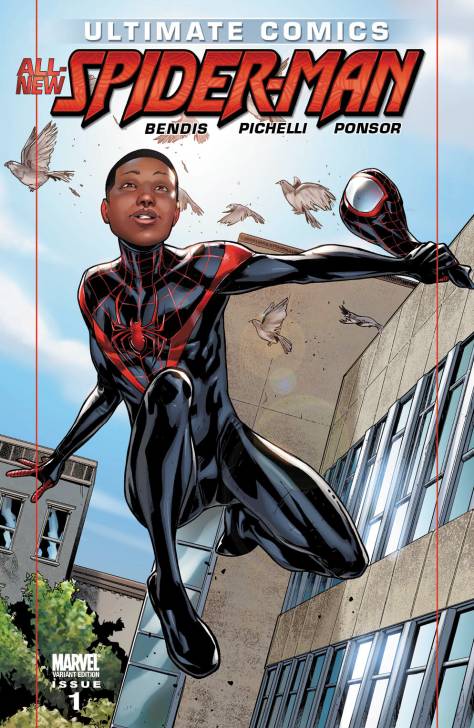
Marvel Comics’ multiverse continues to be well-utilized by creators. Earth-1610 (identified as the “Ultimate Universe”, the home of 21st century updates of the classic Marvel characters) has been the setting of several popular comics titles. Marvel’s upcoming Edge of Spider-Verse series will showcase versions of Spider-Man from across the Marvel multiverse.
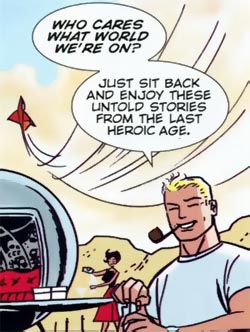
The comic book multiverse is a narrative convention that allows for a huge range of fascinating stories, often featuring altered versions of familiar characters. Although some might argue that a comic book multiverse is confusing to new readers (as some DC Comics editors argued in the 1980s), the multiverse remains a popular concept among many comics fans.
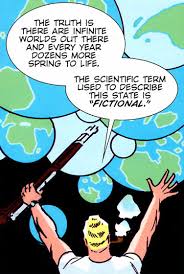
The images above are the property of their respective owner(s), and are presented for educational purposes only under the fair use doctrine of the copyright laws of the United States of America.
SHARE THIS:
Wednesday 13 January 2016

David Litvinoff, The Procurer, by his friend Lucian Freud.
Among those who reportedly provided young boys for the top people in the UK government were David Litvinoff (David Levy) and his half-Jewish friends the Kray Twins.
Litvinoff "was the Faginesque head of a small group based at the Temperance Billiard Hall, 131-141 King's Road, Chelsea."
Litvinoff's niece Vida described Litvinoff as "the court jester to the rich, smart Chelsea set of the sixties".

Litvinoff, of Russian-Jewish origin, was born in Whitechapel in London.
In Notorious, John Pearson writes that Litvinoff procured boys for top people.
Theatrical agent Mim Scala said "what Litvinoff liked best were little boys, particularly naughty, runaway Borstal boys."[13]

The Pheasantry, once home to Litvinoff.
In 1968, shooting started on the gangster film Performance, written by Litvinoff's friend Donald Cammell and co-directed by Cammell and Nicolas Roeg, and starring James Fox and Mick Jagger.
Litvinoff got the job of "dialogue coach and technical adviser".
Litvinoff introduced the cast and crew to London's underworld.[11]
Marianne Faithfull said "They hired real gangsters ... and a genuine mob boss as adviser. This was David Litvinoff."[11]

Jimmy Savile and the military in Wales.
In 1968, Litvinoff rented a cottage in Llanddewi Brefi in Wales.
Among those who allegedly stayed at the cottage were Eric Clapton, Bob Dylan, Jimi Hendrix and Yoko Ono.
In 1977, Operation Julie busted a large LSD manufacturing and distribution network operating partly from Llanddewi Brefi.

Davington Priory, c. 1910.
From 1972 until his death in April 1975 'from an overdose of sleeping pills', Litvinoff lived at Davington Priory in Kent.
Davington Priory is currently the home of Bob Geldof[23])
One witness recalls Litvinoff speaking on the telephone to a confused Brian Jones of The Rolling Stones the night before Jones died.[7]
..
Anonymous writes:
Dolphin Square was where gangland enforcer Chas lived, in Donald Cammell's gay/gangster/psychedelic/occult thriller 'Performance".
Donald Cammell was Aleister Crowley's "godson'…

Litvinoff.
Litvinoff, of Russian-Jewish origin, was born in Whitechapel in London.
In Notorious, John Pearson writes that Litvinoff procured boys for top people.
Theatrical agent Mim Scala said "what Litvinoff liked best were little boys, particularly naughty, runaway Borstal boys."[13]

The Pheasantry, once home to Litvinoff.
In 1968, shooting started on the gangster film Performance, written by Litvinoff's friend Donald Cammell and co-directed by Cammell and Nicolas Roeg, and starring James Fox and Mick Jagger.
Litvinoff got the job of "dialogue coach and technical adviser".
Litvinoff introduced the cast and crew to London's underworld.[11]
Marianne Faithfull said "They hired real gangsters ... and a genuine mob boss as adviser. This was David Litvinoff."[11]

Jimmy Savile and the military in Wales.
In 1968, Litvinoff rented a cottage in Llanddewi Brefi in Wales.
Among those who allegedly stayed at the cottage were Eric Clapton, Bob Dylan, Jimi Hendrix and Yoko Ono.
In 1977, Operation Julie busted a large LSD manufacturing and distribution network operating partly from Llanddewi Brefi.

Davington Priory, c. 1910.
From 1972 until his death in April 1975 'from an overdose of sleeping pills', Litvinoff lived at Davington Priory in Kent.
Davington Priory is currently the home of Bob Geldof[23])
One witness recalls Litvinoff speaking on the telephone to a confused Brian Jones of The Rolling Stones the night before Jones died.[7]
..
Anonymous writes:
Dolphin Square was where gangland enforcer Chas lived, in Donald Cammell's gay/gangster/psychedelic/occult thriller 'Performance".
Donald Cammell was Aleister Crowley's "godson'…
Through Ronnie Kray, Litvinoff met Francis Bacon and Lucian Freud who were friends and used to gamble at Esmerlada's Barn, the gambling club in which the Krays had a stake.
According to Christopher Gibbs, the man in Freud's painting Man in a Headscarf (originally The Procurer) (1954) was Litvinoff before he was slashed across the face in an attack (sometime before 1968) by an unknown assailant.
The Krays were happy to take the credit for the attack as it bolstered their reputation. Pearson claims that Freud gave the work its original name in reference to Litvinoff's function. The painting sold for £1,156,500 at Christie's in 1999.
David Litvinoff - Wikipedia, the free encyclopedia.
According to Christopher Gibbs, the man in Freud's painting Man in a Headscarf (originally The Procurer) (1954) was Litvinoff before he was slashed across the face in an attack (sometime before 1968) by an unknown assailant.
The Krays were happy to take the credit for the attack as it bolstered their reputation. Pearson claims that Freud gave the work its original name in reference to Litvinoff's function. The painting sold for £1,156,500 at Christie's in 1999.
David Litvinoff - Wikipedia, the free encyclopedia.
Sunday 20 December 2015
| VIVIAN STANSHALL |


> Here's a band that truly does deserve
it's cult reputation. Combining comedy, 30's-style music-hall sounds and the wacky, bizarre humour of the band's two major figures Neil Innes and Vivian Stanshall, the Bonzo's had their best time in the late 60's, when they filled large-halls and even had a hit single with "I am the Urban Spaceman".
it's cult reputation. Combining comedy, 30's-style music-hall sounds and the wacky, bizarre humour of the band's two major figures Neil Innes and Vivian Stanshall, the Bonzo's had their best time in the late 60's, when they filled large-halls and even had a hit single with "I am the Urban Spaceman".
Red-haired as Calvert (discretely hidden on the photo you see on the left), and certainly as eccentric (possibly even more), Vivian Stanshall, famous comedian - musician; front-man of the Bonzos; the "court-jester of the underground scene" as John Peel described him.
"The quintessential art school band, the Bonzos were a chaotic mixture of music hall, rock parody and Dada nonsense. Resolutely English, Stanshall & co. brought an absurdist sense of humour to a scene that was already beginning to take itself too seriously."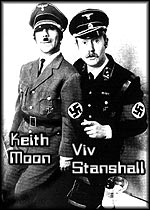 To shed some light on his somewhat bizarre and outrageous sense of humour: he obviously took delight in cruising through the pubs of London with his good friend Keith Moon - wearing Nazi uniforms. What fun! (Read more on Stanshall's career in the article below.) To shed some light on his somewhat bizarre and outrageous sense of humour: he obviously took delight in cruising through the pubs of London with his good friend Keith Moon - wearing Nazi uniforms. What fun! (Read more on Stanshall's career in the article below.)Stanshall made a significant contribution to Calvert's Captain Lockheed and the Starfighters album, performing most of the lead character's in the sketches that appear between the songs, accompanied by Tom Mittledorf, Richard Ealing, Jim Capaldi and Calvert himself. 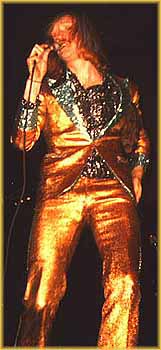 And Calvert obviously knew that Stanshall was THE man for this: Here you can hear Stanshall in top-form, making full use of the whole range of his famous "posh talk" - And Calvert obviously knew that Stanshall was THE man for this: Here you can hear Stanshall in top-form, making full use of the whole range of his famous "posh talk" -writes Pete Dooley: "Stanshall was apparently forcibly taught BBC English by his father, who returned from the war "a changed man". It might have worked out well, but the Stanshalls lived in the East End of London, and so Viv's cultured tones set him apart from the norm at an early age." On Captain Lockheed... Stanshall impersonates all sorts of characters: from the mad-fat German then defense minister Franz Joseph Strauss to a neurotic test-pilot, whose mother crashed while she tried to cross the atlantic single-handedly...and they only found her false eye-lashes, floating on the waves...and that's why he is wearing mascara....for her sacred memory...all clear? Well, get an audio taste of it here - LISTEN to: Two Pilots discussing the Starfighter's performance However, the strange way Calvert and Stanshall got to know each other did not point to a later collaboration - quite on the contrary....: Read the hilarious story of the first meeting of Calvert and Viv Stanshall on the QUOTES pages - told by Arthur Brown who introduced them to each other. <
|
Wednesday 16 September 2015
Tuesday 1 September 2015
Tuesday 18 August 2015
Sunday 19 April 2015
Wednesday 22 January 2014
Friday 22 March 2013
Sunday 27 January 2013
Gavin Turk~
Decisions Illusion Signs Appropriation Eyes Bronze The Artist Camouflage Signature PaintBrand You Drawings Biro Transit Englishness Vehicles The Street Warhol Celebrity ElvisFaces Mazes Fright Wig Icons Trompe L'oeil Packaging Ariadne Sleep The Outsider EggsWhich Came First Screens Les Bikes de Bois Rond Pollocks Signatures Flags Che GuevaraPolitical Symbols Punk Revolution Nail Watercolour Traffic Waste Food Diamond dustWallpaper Body Parts Recycling That's a Wrap The Fool Droste Effect Animalia AutomatonRubbish Clay Domestic Bottles Maps Fakes Cups Piss Clouds Tea Stains En FaceReadymade Shiny Mirrors and Glass Collage Newspaper Font Vitrines Union Jack KleinMagritte Forgery Souvenirs Pipes Cripple Godot Smoking Sid Vicious Fire Hair The EndFound The Age of Anxiety Death of Gavin Turk Masks Money The Blank Page How to be a Dandy Bread Moustaches & Beards Studies Trophies and Awards Trash Culture TrampHomelessness Clothing/Uniforms Military Memorial onomatopoeia Cars Stickers ShoesHeart of Darkness Gentleman Jim Mr Kurz Melons Lotus Paint rollers Branding BoxesFoil Bog Rolls Machines Plinths & Vitrines Beuys Cracked Air Oscar Apples Piero ManzoniPolystyrene Chewing Gum Jewellery Bin Bag Cans Fish and Chips..
Subscribe to:
Posts (Atom)


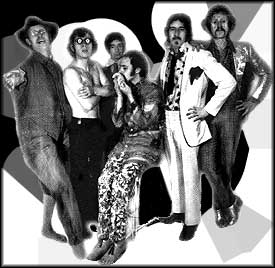
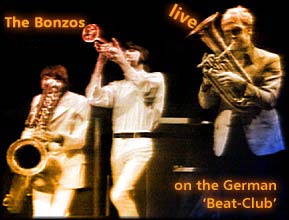 In 1970, the Bonzos went their separate ways. Viv Stanshall immediately launched Big Grunt, who recorded little more than a session for John Peel (and a damn fine one, at that) before Viv suffered a massive, and much-publicised, nervous breakdown.
In 1970, the Bonzos went their separate ways. Viv Stanshall immediately launched Big Grunt, who recorded little more than a session for John Peel (and a damn fine one, at that) before Viv suffered a massive, and much-publicised, nervous breakdown.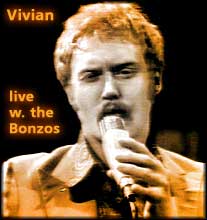 Stanshall re-emerged a year later, filling in for a few weeks on John Peel's radio show. Vivian Stanshall's Radio Flashes, a mix of sketches and music, ran for four episodes and a Christmas special. It was enormously popular and the BBC asked for more. Viv, still recuperating, had looked upon the enterprise as a favour for Peel, felt he couldn't handle the pressure, and declined. Twenty years later, Victor Lewis-Smith, who'd obviously heard Radio Flashes, was doing much the same thing.
Stanshall re-emerged a year later, filling in for a few weeks on John Peel's radio show. Vivian Stanshall's Radio Flashes, a mix of sketches and music, ran for four episodes and a Christmas special. It was enormously popular and the BBC asked for more. Viv, still recuperating, had looked upon the enterprise as a favour for Peel, felt he couldn't handle the pressure, and declined. Twenty years later, Victor Lewis-Smith, who'd obviously heard Radio Flashes, was doing much the same thing.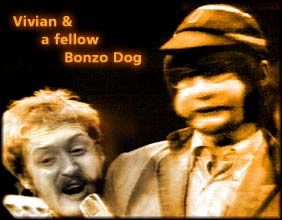 'Sir Henry At Rawlinson End' was the bizarre, sprawling saga of that last bastion of decent English lunacy, Sir Henry Rawlinson, and his various warped relatives and deranged servants. The Rawlinson saga proved to be one of the more popular post-Bonzos projects, spawning a film, a stage play and a book, and it continued to run away with itself on radio right into the early nineties.
'Sir Henry At Rawlinson End' was the bizarre, sprawling saga of that last bastion of decent English lunacy, Sir Henry Rawlinson, and his various warped relatives and deranged servants. The Rawlinson saga proved to be one of the more popular post-Bonzos projects, spawning a film, a stage play and a book, and it continued to run away with itself on radio right into the early nineties.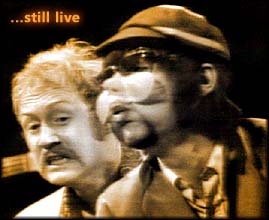 The rest of the 1980s saw Viv's work confined largely to radio, but in 1991 after successfully battling his various demons, Stanshall embarked upon a marathon UK tour to packed houses and rapturous audiences; particularly memorable was a show in Manchester, at which Viv was "adored" by a section of the audience prostrating themselves at his manly feet. Shortly afterwards, his short play Crank was broadcast by the BBC's Late Show.
The rest of the 1980s saw Viv's work confined largely to radio, but in 1991 after successfully battling his various demons, Stanshall embarked upon a marathon UK tour to packed houses and rapturous audiences; particularly memorable was a show in Manchester, at which Viv was "adored" by a section of the audience prostrating themselves at his manly feet. Shortly afterwards, his short play Crank was broadcast by the BBC's Late Show.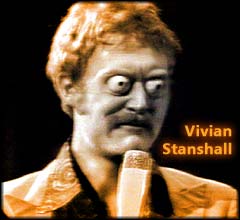 By the beginning of 1995, Viv had clinched the album deal that had eluded him for so long, and a new album of Rawlinson End material was on the cards. Whether or not anything had been recorded, and if it'll be released, remains to be seen.
By the beginning of 1995, Viv had clinched the album deal that had eluded him for so long, and a new album of Rawlinson End material was on the cards. Whether or not anything had been recorded, and if it'll be released, remains to be seen.
